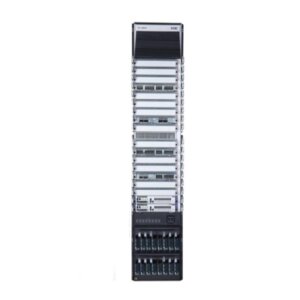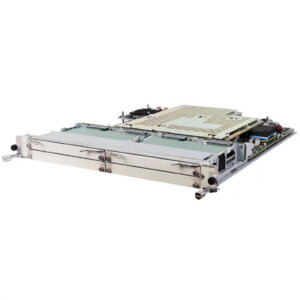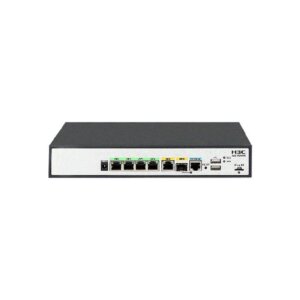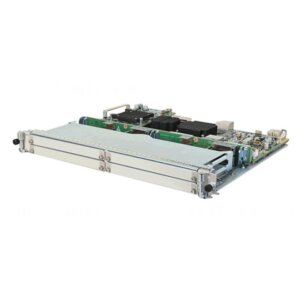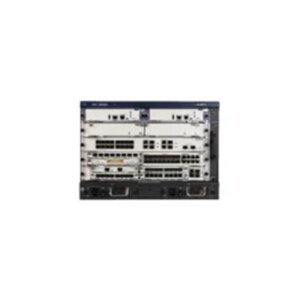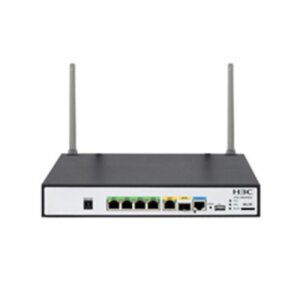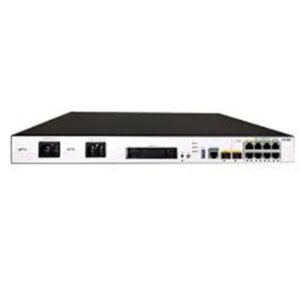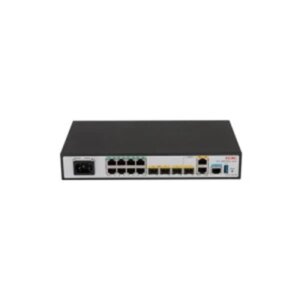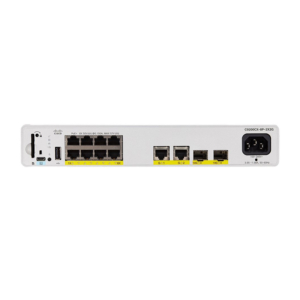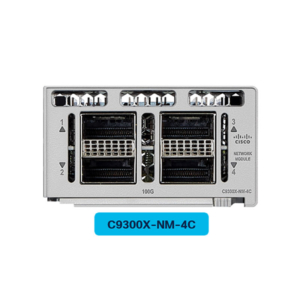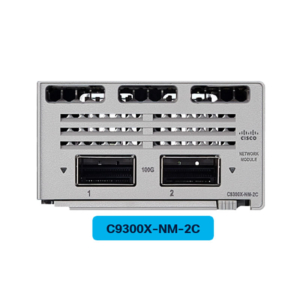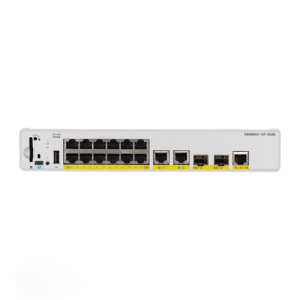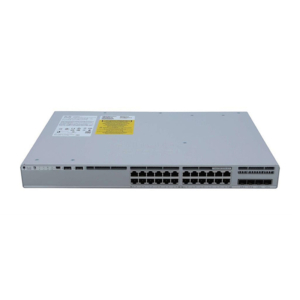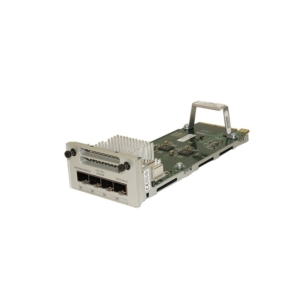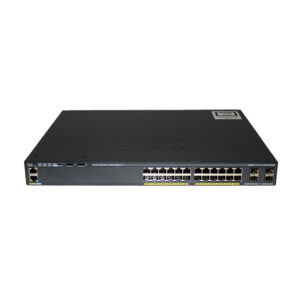MSR5600 router series is designed to meet the new challenges and requirements that wide deployment of cloud services brings to networking.
 Hoja de datos de la serie de enrutadores H3C MSR5600
Hoja de datos de la serie de enrutadores H3C MSR5600
Especificaciones de hardware
| Artículo | MSR5620 | MSR5660 |
| UPC | 1.2GHz | 1.5GHz |
| DRACMA | SPU: 2G/2G | SPU-400-X1: 4G/4G
SPE-S1: 2G/2G SPE-S3: 8G/8G |
| Rendimiento de reenvío en servicio (MEZCLO) | 7.5Gbps | SPU-400-X1: 20Gbps
SPU-600-X1+SPE-S1: 5Gbps SPU-600-X1+SPE-S3: 50Gbps SPU-600-X1+2*SPE-S1: 10Gbps SPU-600-X1+2*SPE-S3: 100Gbps |
| IPSec performance(iMIX) | 2Gbps | SPU-400-X1: 7Gbps
SPU-600-X1+SPE-S1: 2Gbps SPU-600-X1+SPE-S3: 20Gbps SPU-600-X1+2*SPE-S1: 4Gbps SPU-600-X1+2*SPE-S3: 40Gbps |
| Backplane bandwidth | 135Gbps | 670Gbps |
| USB 2.0 puerto | 1/2, support for USB 3G/4G modem | 1/1, support for USB 3G/4G modem |
| Fixed GE port | 3 × puertos combinados GE
2 × puertos SFP+ |
SPU-400-X1: 10 × GE combo ports+4 × SFP+ ports
SPE-S1: 4 × GE combo ports+4 × SFP ports SPE-S3: 8 × puertos SFP+ |
| Console/AUX port | 1 | 1 |
| Management Ethernet Port | 1 | 1 |
| ranura SIC | 4 | N / A |
| HMIM slot | 2 | 6 |
| DHMIM slot | N / A | 1 |
| Consumo máximo de energía | 450 W. | 450 W. |
| Power module redundancy | Two built-in power modules | Support for built-in AC/DC power modules and N+1 power module redundancy |
| Tensión de alimentación | C.A.: 100 VAC a 240 VAC @ 50 Hz/60 Hz
corriente continua: –48 to –60V |
C.A.: 100 VAC a 240 VAC @ 50 Hz/60 Hz
corriente continua: –48 to –60V |
| Altura del estante | 2 ru | 4 ru |
| Dimensiones (Alto × Ancho × Fondo) | 88.1 × 440 × 480 milímetro (3.47 × 17.32 × 18.90 en) | 175.1 × 440 × 480 milímetro (6.89 × 17.32 × 18.90 en) |
| Temperatura de funcionamiento | 0ºC a 45ºC (32°F a 113°F) | 0ºC a 45ºC (32°F a 113°F) |
| Humedad de funcionamiento | 5% derecha a 95% RH, sin condensación | 5% derecha a 95% RH, sin condensación |
| CEM | Parte de la FCC 15 (CFR 47) CLASE A
CIEM-003 CLASE A VCCI-3 CLASE A VCCI-4 CLASE A CISPR 22 CLASE A EN 55022 CLASE A AS/NZS CISPR22 CLASE A CISPR 24 EN 55024 EN 61000-3-2 EN 61000-3-3 EN 61000-6-1 BUSCAR ES 300 386 EN 301 489-1 EN 301 489-17 |
Parte de la FCC 15 (CFR 47) CLASE A
CIEM-003 CLASE A VCCI-3 CLASE A VCCI-4 CLASE A CISPR 22 CLASE A EN 55022 CLASE A AS/NZS CISPR22 CLASE A CISPR 24 EN 55024 EN 61000-3-2 EN 61000-3-3 EN 61000-6-1 BUSCAR ES 300 386 EN 301 489-1 EN 301 489-17 |
| Seguridad | UL 60950-1
CAN/CSA C22.2 No 60950-1 CEI 60950-1 EN 60950-1/A11 AS/Nueva Zelanda 60950 EN 60825-1 EN 60825-2 FDA 21 CFR Subcapítulo J ES 4943 |
UL 60950-1
CAN/CSA C22.2 No 60950-1 CEI 60950-1 EN 60950-1/A11 AS/Nueva Zelanda 60950 EN 60825-1 EN 60825-2 FDA 21 CFR Subcapítulo J ES 4943 |
Especificaciones del programa
| Artículo | Especificación |
| Capa 2 traspuesta | ethernet, EthernetII, VLAN (VLAN basada en puerto, VLAN invitada), 802.3X, 802.1pag, 802.1q, 802.1X, STP (802.1D), RSTP (802.1w), MSTP (802.1s), APP, Cliente PPPoE, servidor PPPoE, HDLC, DDR, modem, and ISDN |
| servicios de propiedad intelectual | Unidifusión/multidifusión, tcp, UDP, opción IP, IP sin numerar, enrutamiento basado en políticas, NetStream, y flujo
ECMP CMP |
| solicitud de propiedad intelectual | Silbido, tracert, ICMP, Servidor DHCP, retransmisión DHCP, cliente DHCP, DHCP snooping, DNS client, proxy DNS, DDNS, IP Accounting, Ayudante UDP, NTP, y SNTP |
| enrutamiento IPv4 | Enrutamiento estatico
Enrutamiento dinámico: RIPv1/v2, OSPFv2, BGP, ES-ES iteración de ruta Enrutamiento de políticas Enrutamiento multiruta de igual costo (ECMP) Enrutamiento de multidifusión: IGMP v1/v2/v3, PIM-DM, PIM-SM, MBGP, MSDP |
| IPv6 | IPv6 ND, IPv6 PMTU, FIB IPv6, ACL IPv6, NAT-PT, 6EDUCACIÓN FÍSICA, y DS-LITE
Túnel IPv6: Túneles manuales, tunelización automática, túnel GRE, 6para 4, ISATAP Enrutamiento estatico Enrutamiento dinámico: RIP, OSPFv3, IS-ISv6, BGP4+ Multidifusión IPv6: MLDv1/v2, PIM-DM, PIM-SM |
| QoS | LR, duplicación basada en puertos, Modo de confianza del puerto, y prioridad portuaria
Tasa de acceso comprometido (AUTO) FIFO, WFQ, CQB Modelado de tráfico genérico (GTS) Clasificación del tráfico |
| 3G/4G | Support for 3G modems
Support for TD-SCDMA, CDMA2000/EVDO, and WCDMA/HSPA+ |
| Seguridad | Cliente PPPoE & servidor, portal, 802.1X
Autenticación local, RBAC, RADIO, TACACS+ Función básica de firewall, ASPF, LCA, filtrar, límite de conexión IKE, IPSec ADVPN, VPN SSL, GDVPN L2TP, NAT/TNA, PKI, RSA, SSH v1.5/2.0, URPF, mGRE, GRE Prevención de ataques ARP AES, DESDE, 3DESDE,MD5, SHA1 Defensa de admisión de terminales (EAD) EVI, VXLAN |
| MPLS | PLD, LSP estático
L3VPN: Inter-AS MPLS VPN (Opción 1/2/3), VPN anidada MPLS, jerarquía de PE (Esperanza), CE de doble hogar, MCE, y anfitrión polivalente L2VPN: martini, compella, CCC PW y PW estáticos MPLS TE, Confirma tu asistencia |
| Alta disponibilidad | IRF2
VRRP, VRRPv3 Muti-link load-balancing and backup Colaboración de NQA con enrutamiento, VRRP o copia de seguridad de la interfaz BFD collaboration with MPU active/standby switchover |
| Gestión y mantenimiento | SNMP v1/v2c/v3, MIB, SYSLOG, RMÓN
Gestión remota BiMS, arrancando desde una unidad USB CLI, sistema de archivos, y doble imagen DHCP, ftp, HTTP, ICMP, público UDP, UDP privado, TCP público, TCP privado, y SNMP Inicio de sesión en el puerto de consola, Telnet (VTY) acceso, inicio de sesión ssh, e inicio de sesión FTP |
 Proveedor de equipos de red de TI
Proveedor de equipos de red de TI

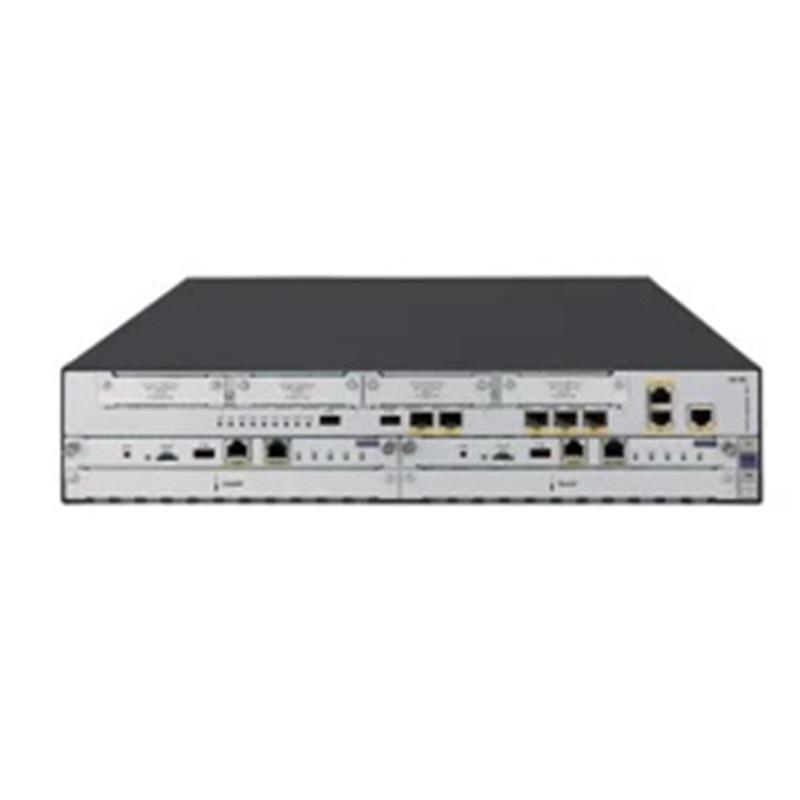
 es original tu producto?
es original tu producto? Sí, nuestro producto es original, Solo vendemos productos H3C originales..
Sí, nuestro producto es original, Solo vendemos productos H3C originales..



